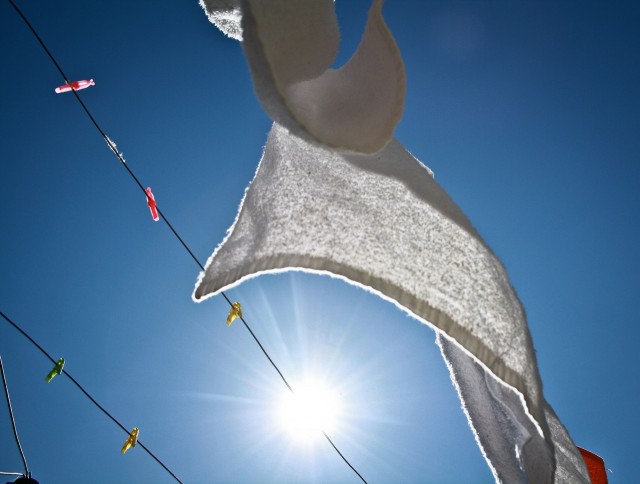Backyard Brutalism

When I first inspected the property which was to become our new home, the presence of the Hills Hoist was one of the things I was most excited by. Beside myself, to be more accurate. In 2200 square metres of well established, cold-climate garden, this brutalist folly completely tickled my fancy. My husband, however was not so enamoured and promptly began to campaign for its removal. All he saw was an ugly, explosive spike, surrounded by weeds – not the promise and persuasion of sun-dried sheets. Where a more modern equivalent might be placed, wasn’t immediately obvious and so happily, my sense of suburban sentimentality prevailed.
For me, a fresh flotilla of wash floating above the earth is the very essence of satisfaction. It says blue skies ahead and an ever present reminder of a time when swinging on the clothes line was the height of risque behaviour; something only to be attempted when your parent’s line of sight was obscured. My enthusiasm for Lance Hill’s inventive clothes hoist, however, goes beyond nostalgia.
If the maxim ‘form follows function’ is more than mere truism, then you need look no further than the Hills Hoist. A triumph of utilitarianism, they’re built to last – a rare thing in this age of built-in obsolescence – which perhaps goes a little way in explaining the enduring romance of the Hills Hoist. Designed with the express purpose of making his wife’s life easier, Lance Hill’s 1945 prototype was initially made from scrap metal. The winding mechanism and rotating frame allows washing to catch the breeze and therefore, dry more effectively. Aside from a few refinements to the surface finish, today’s Hills Hoists aren’t significantly different to the original.
Lance Hill’s entrepreneurial nous meant that his version prevailed but he wasn’t the first to tinker with the concept of a rotary clothes line. The James Hardie company had patented the Drywell in 1925 and just around the corner from Hill’s Adelaide home, Gilbert Toyne had been patenting his designs since 1911. With 13 children in the Toyne household, the motivation behind the man, was once again, a woman. Whether these overlaps represent nothing more than simple plagiarism is lost in the folding of time, especially as James R Higgins had his device featured in the 1855 edition of the “Scientific American.” What we have come to regard as a quintessentially Australian innovation is not as uniquely Australian as we might like but remains a proud sentinel within our cultural landscape all the same.
Once our new abode was officially ours, my first project in Magic Garden was to clean out the beds beneath my hoist. I improved the soil and set about creating an aromatic kitchen / laundry garden. I retained a pale apricot rose bush and transplanted the sickly wisteria into half a wine barrel. There’s now a fat ring of lavender around the central pole. A rosemary cutting from my old garden nestles against some Turkish thyme and I purchased a new sage plant because I really couldn’t wait for seeds to sprout. Chives have repeatedly self seeded amongst the catnip, oregano and flat leaf parsley. It’s a joy to wind up the hoist and know that with the wind at work, my wash is impregnated with these scents. I’m embarrassed to admit however, that there’s no swinging on my Hills Hoist. At well over sixty years old, I think the old girl deserves a reprieve and I’d be devastated if she were to collapse at this stage, plus I’m terrified my four year old will drop into the rose bush. I’d never describe myself as a helicopter parent but I guess in this instance, I am!
As I hang out my wash, I often think of my Mum’s strict laundry protocol; always peg under the armpits and by the waistband, fold as you bring in the load. According to Mum, it is permissible to leave the pegs up, a practise which my Mother-in-law firmly disapproves. Sometimes I sing, ‘wet washing hanging on the line, drying very quickly when the weather’s fine,’ which in turn reminds me that not all the days of my childhood were sunny. There were times each year, often around Easter and before Christmas when it seemed to rain for weeks. Our covered deck would became a tangle of damp, manky washing that Mum would refuse to put in the dryer. I could paint her as an early environmentalist but it was much more like single mum with an eagle eye on the electricity bill. It wasn’t until I moved mountainside that my love-hate relationship with the dryer began.
Carbon footprints and climate change aside, it seems to me that the humble washing line is in retreat. People are so quick to rip out the ugly, rather than see that the beauty behind is amplified in response. I understand that increased density in housing means that space is at a premium and not everyone has room to swing a cat, let alone off a Hills Hoist. But that shouldn’t justify rejecting line drying; even the smallest yards can cope with a retractable wall mounted set-up. It doesn’t have to be a Hills Hoist, just in the sunniest spot you can find.
Whilst the perennial sore thumb for some and the most delightful juxtaposition for others, the humble clothes line represents a unique contribution to the fabric of our communities. When we stay over at a friend’s place, we expect to do so on clean sheets. When our visit ends, we strip the bed and offer to put on a load. If I get run over by a bus, I do want to be wearing clean knickers. Just as we teach our children to wash their hands before they eat and brush their teeth after, the very act of washing, folding and wearing clean clothes is the equivalent of a box of Roses chocolates, it says that you care. It’s not just the environment that will thank you; the unexpected upside is that reaching up to peg is great for your bingo wings.
WORDS by Keris Macarthur IMAGES by Camille Walsh
Please note: the image featured on the front page came from the super cute Mrs Washalot blog. I am now desperate to find myself a genuine Hills Hoist peg basket…








Thanks for making “hanging out the washing” seem like fun. Really enjoyed reading your whimsical essay.
Thanks for reading Gail! Between brilliant sunshine and dramatic storms, hanging out my washing feels like an epic battle at the moment but just have to keep fighting the good fight and try to keep up with the folding. Here’s to continued blue skies, KM